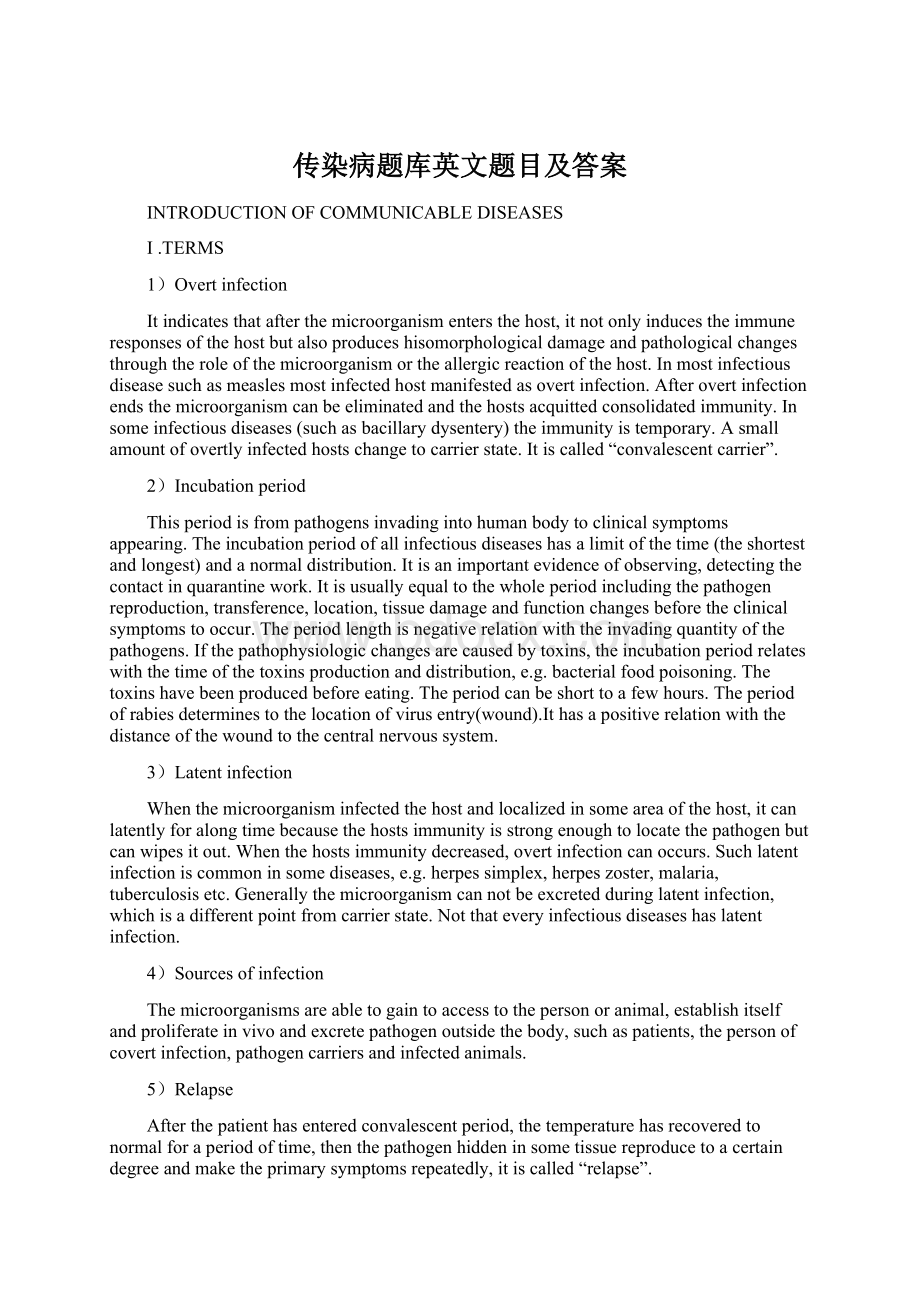传染病题库英文题目及答案.docx
《传染病题库英文题目及答案.docx》由会员分享,可在线阅读,更多相关《传染病题库英文题目及答案.docx(18页珍藏版)》请在冰豆网上搜索。

传染病题库英文题目及答案
INTRODUCTIONOFCOMMUNICABLEDISEASES
I.TERMS
1)Overtinfection
Itindicatesthatafterthemicroorganismentersthehost,itnotonlyinducestheimmuneresponsesofthehostbutalsoproduceshisomorphologicaldamageandpathologicalchangesthroughtheroleofthemicroorganismortheallergicreactionofthehost.Inmostinfectiousdiseasesuchasmeaslesmostinfectedhostmanifestedasovertinfection.Afterovertinfectionendsthemicroorganismcanbeeliminatedandthehostsacquittedconsolidatedimmunity.Insomeinfectiousdiseases(suchasbacillarydysentery)theimmunityistemporary.Asmallamountofovertlyinfectedhostschangetocarrierstate.Itiscalled“convalescentcarrier”.
2)Incubationperiod
Thisperiodisfrompathogensinvadingintohumanbodytoclinicalsymptomsappearing.Theincubationperiodofallinfectiousdiseaseshasalimitofthetime(theshortestandlongest)andanormaldistribution.Itisanimportantevidenceofobserving,detectingthecontactinquarantinework.Itisusuallyequaltothewholeperiodincludingthepathogenreproduction,transference,location,tissuedamageandfunctionchangesbeforetheclinicalsymptomstooccur.Theperiodlengthisnegativerelationwiththeinvadingquantityofthepathogens.Ifthepathophysiologicchangesarecausedbytoxins,theincubationperiodrelateswiththetimeofthetoxinsproductionanddistribution,e.g.bacterialfoodpoisoning.Thetoxinshavebeenproducedbeforeeating.Theperiodcanbeshorttoafewhours.Theperiodofrabiesdeterminestothelocationofvirusentry(wound).Ithasapositiverelationwiththedistanceofthewoundtothecentralnervoussystem.
3)Latentinfection
Whenthemicroorganisminfectedthehostandlocalizedinsomeareaofthehost,itcanlatentlyforalongtimebecausethehostsimmunityisstrongenoughtolocatethepathogenbutcanwipesitout.Whenthehostsimmunitydecreased,overtinfectioncanoccurs.Suchlatentinfectioniscommoninsomediseases,e.g.herpessimplex,herpeszoster,malaria,tuberculosisetc.Generallythemicroorganismcannotbeexcretedduringlatentinfection,whichisadifferentpointfromcarrierstate.Notthateveryinfectiousdiseaseshaslatentinfection.
4)Sourcesofinfection
Themicroorganismsareabletogaintoaccesstothepersonoranimal,establishitselfandproliferateinvivoandexcretepathogenoutsidethebody,suchaspatients,thepersonofcovertinfection,pathogencarriersandinfectedanimals.
5)Relapse
Afterthepatienthasenteredconvalescentperiod,thetemperaturehasrecoveredtonormalforaperiodoftime,thenthepathogenhiddeninsometissuereproducetoacertaindegreeandmaketheprimarysymptomsrepeatedly,itiscalled“relapse”.
6)Recrudescence
Intheconvalescentperiodofsomepatients,thetemperaturehasnotstablydecreasedtonormalandthefeverriseagain,itiscalled“recrudescence”.
7)Zoonoses
Somenaturalecologicenvironmentissuitabletothetransmissionofinfectiousdiseasesamongwildanimals.Thesediseasesincludeplaguetsutsugamushidisease,leptospirosis,andsoon.Thehumanracemaybeinfectedwhenhegetintotheseareas.Thesediseasesarecalled“zoonoses”.
II.QUESTIONS
1)Pleasebrieflydescribethemanifestationsofinfectiousdiseases(infectionspectrum).
Infectiousprocessstartswhenmicroorganismsenterthehumanhostthroughvariousways.Whetherthemicroorganismiseliminatedorcolonizedinthehost,itismainlydependentonthepathogenicityofthepathogenandtheimmunefunctionofthehost.
i.Pathogeniseliminatedbyhostimmunity:
Afterthemicroorganismentersthehostitcanbewipedoutbynon-specificimmunity,anderadicatedoreliminatedbyspecificimmunitywhichthehosthasgotbeforetheinfectiousprocess.
ii.Covertinfection:
Itreferstothatthemicroorganismonlymakingthehostproducingspecificimmuneresponsenothavinghistomorphologicaldamageorevenhavingmildfeatureafteritentersthehost.Clinically,thereisnoanysymptomsandsignsoranybiochemicalchanges.
iii.Overtinfection:
Itindicatesthatafterthemicroorganismentersthehost,itnotonlyinducestheimmuneresponsesofthehostbutalsoproduceshisomorphologicaldamageandpathologicalchangesthroughtheroleofthemicroorganismortheallergicreactionofthehost.
iv.Carrierstates:
Itisdividedintoviruscarrierandbacteriacarrieraccordingtodifferentpathogens.Allcarrierstateshaveacommoncharacteristicthatisnoclinicalmanifestationbutthemicroorganismcanbeexcretedduringthestate.
v.Latentinfection:
Whenthemicroorganisminfectedthehostandlocalizedinsomeareaofthehost,itcanlatentlyforalongtimebecausethehostsimmunityisstrongenoughtolocatethepathogenbutcannotwipeitout.Whenthehostsimmunitydecrease,overtinfectioncanoccurs.
2)Pleasebrieflydescribethefactorsrelatedtothepathogenicityofthepathogenintheinfectiousprocess.
i.Invasiveness:
Itreferstoitsabilitytoinvadethehostandspreadwithinthehost.
ii.Virulence:
Itincludesthetoxinsandvariousenzymes.
iii.Numberofthepathogen:
Thenumberofinvadingpathogenispositiverelationwiththepathogenicityinthesameinfectiousdisease.Theleastnumberofthepathogentoinducediseasediffergreatlyindifferentdiseases.
iv.Variability:
Pathogenscanproducevariationduetoenvironmentalandhereditaryfactors.Generallyspeaking,undertheenvironmentofartificialculture,thepathogenicityofthepathogenwilldecrease.Therepeatedspreadbetweenthehostswillincreasethepathogenicityofthepathogen.Theantigenicvariationofthepathogenwillmakethepathogenescapeformthespecificimmunityofthehostandcontinueinducethedisease.
3)Pleasebrieflydescribethebasiccharacteristicsofinfectiousdiseases.
i.Pathogen:
Everyinfectiousdiseaseiscausedbyaspecificpathogenincludingmicroorganismandparasite.Inhistorymanyinfectiousdiseaseswerefirstunderstoodbytheirclinicalmanifestationsandepidemiologicfeatureandthenthepathogenwasfound.
ii.Infectivity:
Infectivitymeansthatthepathogencanbeexcretedtocontaminatethesurrounding.Itisthemaindistinctionbetweentheinfectiousdiseasesandotherinfection.Everyinfectiousdiseasehasconsiderablyastableinfectiveperiod,whichcanbeusedasaruletoisolatethepatient.
iii.Epidemiologicfeature:
Undertheinfluenceofnaturalandsocialfactorstheinfectiousprocessmanifestatesvariouscharacteristics.Itcanbedividedintotheexoticityandtheendemicity.Italsocanbedividedintosporadic,epidemicandpandemic.Thedistributionoftheincidenceoftheinfectiousdiseaseintime(seasonaldistribution),inspace(regionaldistribution)anddifferentpopulations(age,sex,andoccupation)isalsoanepidemiologicfeature.
iv.Postinfectionimmunity:
Thehostcanproducespecificprotectiveimmunitywhichisdirectedatthepathogenoritsproductsafterthehostwasinfectedbythepathogen.Postinfectionimmunitybelongstoactiveimmunity.Thelastingtimeofpostinfectionimmunityvarieswithdifferentinfectious.
VIRUSHEPATITISB
I.TERMS
1)Daneparticle
ThecompleteHBViscalledDaneparticle.The42-nmDaneparticleismadeupofanoutershell7nmthick,containingthehepatitisBsurfaceantigen,glucoproteinandcellularfat,andaninnercore28nmindiameter,whichpossessesitsownspecificantigen,thehepatitiscoreantigen(HBcAg).TheDaneparticlecorecanbebrokendownbytreatmentwithdetergenttorevealaDNApolymeraseandadoublestrandedcircularDNAgenomethatcanserveasaprimarytemplateinvitrofortheDNApolymerase.
2)Windowphase
Anti-HBcIgMpersists6to18months,sorepresentsanacuteresponsetoanewlyinfectionofHBVinacutecaseswhohaveclearedtheHBsAgbuthavenotdemonstrateddetectableamountsofanti-HBs,anti-HBcandanti-HBecanbedetectable,theserologicgapiscalledwindowphase.Inthiscase,anti-HBcIgMmaybetheonlyevidencefordiagnosinganacuteHBVinfection.
3)HBsAg
ItstandsforHepatitisBsurfaceantigen.ItiscodedfortheproteinoftheviralenvelopebytheSgene.TherearefourantigenicsubtypesofHBsAg.Theyareadr,adw,ayr,andayw.HBsAgisnon-infectiousitself,butHBsAg-positivebloodshouldbeconsideredpotentiallyinfectiousbecauseitmaycontaincompleteHBV(Daneparticles).
4)ChronicHBsAgcarrier
SomepersonsinfectedwithhepatitisBvirusdevelopmildchronicinfectionstatethatisasymptomaticandnotassociatedwithanysignificantliverfunctiontestsabnormalityexceptpersistentserumHBsAg-positivemorethan6months.However,liverbiopsyrevealsthatonlyaminorityofthemiswithnormalhistology;andthemajoritycasespresentmorphologicliverdamageinvaryingdegrees,rangingformminimalinflammation,chronicpersistenthepatitis,chromicactivehepatitis,orevencirrhosis.
5)HBVDNA
HepatitisBvirus(HBV)containsasmallcircularDNAmoleculethatispartiallydouble-stranded,theDNAconsistsofalongstrand(L)ofconstantlength(3,200bases)inallmoleculesandashortstrand,whichvariesinlengthbetween1,700-2,800basesindifferentmolecules.ADNApolymeraseactivityinthevirionrepairsthesingle-strandedmoleculesof3,200basespairs.ThefouropenreadingframesoftheHBVaretermedS,C,PandX.
II.QUESTIONS
1)PleasebrieflydescribetheregionsoftheHBVgeneandtheproteintheycodefor.
ThefouropenreadingframesoftheHBVaretermedS,C,PandX.TheSregioncodesfortheproteinoftheviralenvelopeandisdividedintotheSgene,pre-S1regionandpre-S2region.TheCgenecodesforthecoreprotein.ThePregion,codesfortheviralDNApoly